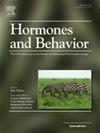Hormonal and sex-specific functional genomic pathways of genetic risk candidates in autism spectrum disorder: evidence of sex-over-chance effects
IF 2.4
3区 医学
Q2 BEHAVIORAL SCIENCES
引用次数: 0
Abstract
Autism spectrum disorder (ASD) is a complex neurodevelopmental condition marked by substantial sex differences in prevalence, with males more frequently diagnosed than females. While genetic and environmental factors contribute to ASD, there is growing evidence that sex-specific endocrine pathways, particularly those involving sex hormones, may play a critical role in ASD etiology. This study aimed to investigate the functional network robustness and annotations of autism spectrum disorder genetic risk candidates (ASD-GRCs), with a focus on endocrine pathways and their impact on network connectivity. Using data from the Simon's Foundation Autism Research Initiative (SFARI) and functional network analysis via the STRING database, we assessed the connectivity of ASD-related genes by randomly subtracting sets of genes from the whole ASD gene network in subsets associated with androgen-testosterone, estrogen-progesterone, and other hormone pathways.
Our findings reveal a significant “sex-over-chance” association, with androgen- and estrogen-related gene subsets showing marked connectivity within the ASD gene network compared to non-sex hormone genes. These results suggest that sex hormones may uniquely influence ASD-related neural development, providing support for the “female protective effect” and the androgen-driven model of ASD. Additional analyses of other hormonal pathways, such as oxytocin and cortisol, showed a lower connectivity impact, reinforcing the distinctive role of sex hormones in ASD. This study highlights the potential of endocrine-focused genetic analysis in understanding ASD, emphasizing sex-specific biological mechanisms that may inform future diagnostic and therapeutic strategies.
自闭症谱系障碍遗传风险候选者的激素和性别特异性功能基因组途径:性别机会效应的证据
自闭症谱系障碍(ASD)是一种复杂的神经发育疾病,其患病率存在显著的性别差异,男性比女性更常被诊断出来。虽然遗传和环境因素会导致ASD,但越来越多的证据表明,性别特异性内分泌途径,特别是涉及性激素的内分泌途径,可能在ASD病因学中发挥关键作用。本研究旨在研究自闭症谱系障碍遗传风险候选者(autism spectrum disorder genetic risk candidate, ASD-GRCs)的功能网络鲁棒性和注释,重点关注内分泌通路及其对网络连接的影响。利用西蒙基金会自闭症研究计划(SFARI)的数据和通过STRING数据库进行的功能网络分析,我们通过从整个ASD基因网络中随机减去与雄激素-睾酮、雌激素-孕酮和其他激素通路相关的亚群的基因集来评估ASD相关基因的连通性。与非性激素基因相比,我们的研究结果揭示了一种显著的“性别过度”关联,与雄激素和雌激素相关的基因亚群在ASD基因网络中显示出显著的连通性。这些结果表明性激素可能是影响ASD相关神经发育的唯一因素,为“女性保护效应”和雄激素驱动的ASD模型提供了支持。对其他激素通路(如催产素和皮质醇)的进一步分析显示,其连通性影响较低,这加强了性激素在ASD中的独特作用。这项研究强调了以内分泌为中心的遗传分析在理解ASD方面的潜力,强调了性别特异性的生物学机制,可能为未来的诊断和治疗策略提供信息。
本文章由计算机程序翻译,如有差异,请以英文原文为准。
求助全文
约1分钟内获得全文
求助全文
来源期刊

Hormones and Behavior
医学-行为科学
CiteScore
6.70
自引率
8.60%
发文量
139
审稿时长
91 days
期刊介绍:
Hormones and Behavior publishes original research articles, reviews and special issues concerning hormone-brain-behavior relationships, broadly defined. The journal''s scope ranges from laboratory and field studies concerning neuroendocrine as well as endocrine mechanisms controlling the development or adult expression of behavior to studies concerning the environmental control and evolutionary significance of hormone-behavior relationships. The journal welcomes studies conducted on species ranging from invertebrates to mammals, including humans.
 求助内容:
求助内容: 应助结果提醒方式:
应助结果提醒方式:


